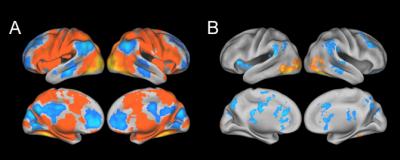Researchers find neural compensation in people with Alzheimer's-related protein

Shown are fMRI scans across all subjects in the study. The yellow and red areas in Section A represent parts of the brain that are activated while subjects are forming 'gist memories' of pictures viewed. Section B represents areas of increased activation, shown in yellow and red, as detailed memories are being formed. Credit: Image courtesy of Jagust Lab
The human brain is capable of a neural workaround that compensates for the buildup of beta-amyloid, a destructive protein associated with Alzheimer's disease, according to a new study led by researchers at the University of California, Berkeley.
The findings, to be published Sunday, Sept. 14, in the journal Nature Neuroscience, could help explain how some older adults with beta-amyloid deposits in their brain retain normal cognitive function while others develop dementia.
“This study provides evidence that there is plasticity or compensation ability in the aging brain that appears to be beneficial, even in the face of beta-amyloid accumulation,” said study principal investigator Dr. William Jagust, a professor with joint appointments at UC Berkeley's Helen Wills Neuroscience Institute, the School of Public Health and Lawrence Berkeley National Laboratory.
Previous studies have shown a link between increased brain activity and beta-amyloid deposits, but it was unclear whether the activity was tied to better mental performance.
The study included 22 healthy young adults and 49 older adults who had no signs of mental decline. Brain scans showed that 16 of the older subjects had beta-amyloid deposits, while the remaining 55 adults did not.
The researchers used functional magnetic resonance imaging (fMRI) to track the brain activity of subjects in the process of memorizing pictures of various scenes. Afterwards, the researchers tested the subjects' “gist memory” by asking them to confirm whether a written description of a scene – such as a boy doing a handstand – corresponded to a picture previously viewed. Subjects were then asked to confirm whether specific written details of a scene – such as the color of the boy's shirt – were true.
“Generally, the groups performed equally well in the tasks, but it turned out that for people with beta-amyloid deposits in the brain, the more detailed and complex their memory, the more brain activity there was,” said Jagust. “It seems that their brain has found a way to compensate for the presence of the proteins associated with Alzheimer's.”
What remains unclear, said Jagust, is why some people with beta-amyloid deposits are better at using different parts of their brain than others. Previous studies suggest that people who engage in mentally stimulating activities throughout their lives have lower levels of beta-amyloid.
“I think it's very possible that people who spend a lifetime involved in cognitively stimulating activity have brains that are better able to adapt to potential damage,” said Jagust.
Co-lead authors of the study are Jeremy Elman and Hwamee Oh, both of whom were postdoctoral researchers in Jagust's lab.
The National Institute on Aging and the McKnight Foundation helped support this research.
Media Contact
More Information:
http://www.berkeley.edu/index.htmlAll latest news from the category: Health and Medicine
This subject area encompasses research and studies in the field of human medicine.
Among the wide-ranging list of topics covered here are anesthesiology, anatomy, surgery, human genetics, hygiene and environmental medicine, internal medicine, neurology, pharmacology, physiology, urology and dental medicine.
Newest articles

Bringing bio-inspired robots to life
Nebraska researcher Eric Markvicka gets NSF CAREER Award to pursue manufacture of novel materials for soft robotics and stretchable electronics. Engineers are increasingly eager to develop robots that mimic the…

Bella moths use poison to attract mates
Scientists are closer to finding out how. Pyrrolizidine alkaloids are as bitter and toxic as they are hard to pronounce. They’re produced by several different types of plants and are…

AI tool creates ‘synthetic’ images of cells
…for enhanced microscopy analysis. Observing individual cells through microscopes can reveal a range of important cell biological phenomena that frequently play a role in human diseases, but the process of…





















